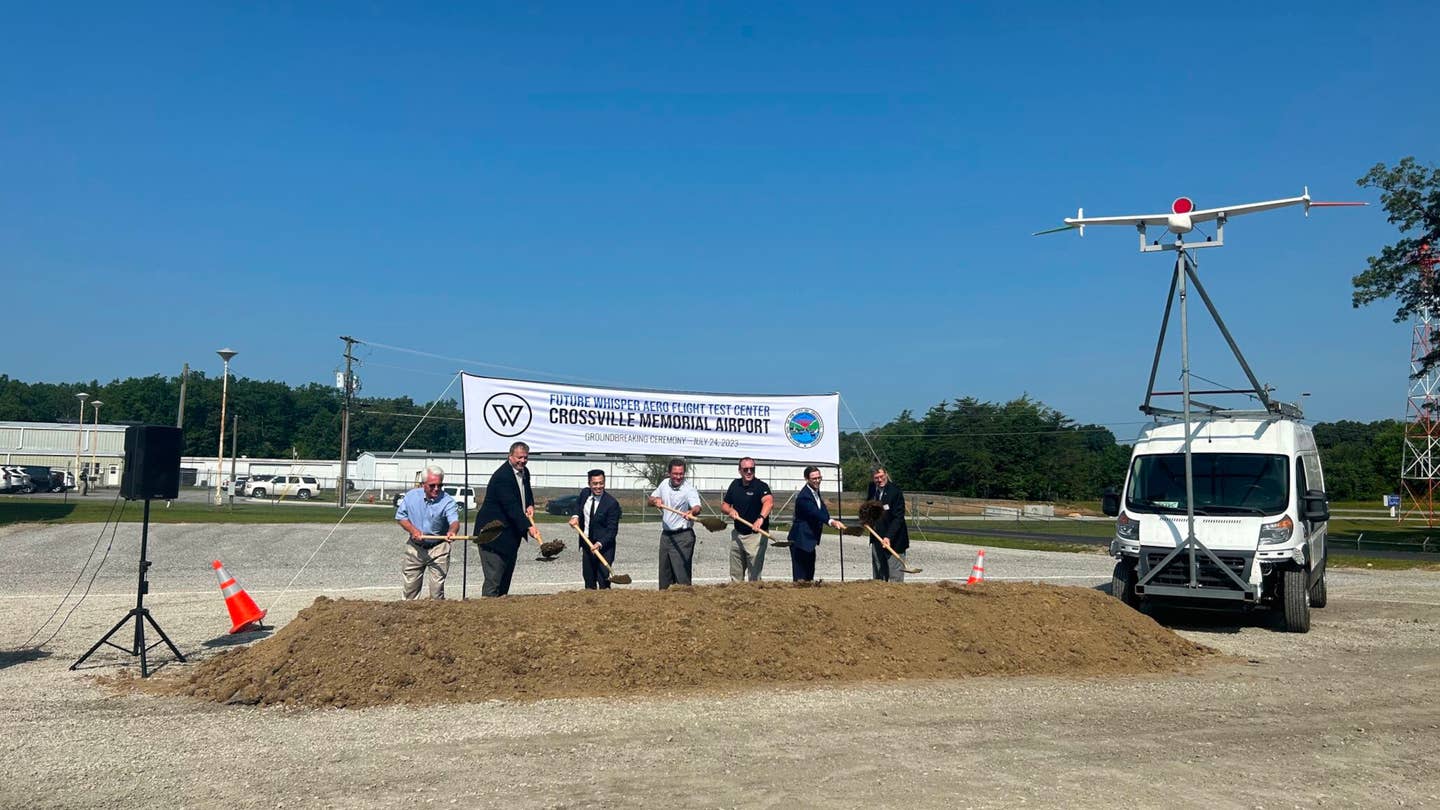Whisper Aero Announces New Flight Test Center to Develop Ultraquiet Propulsion
Company claims to reduce aircraft noise to a whisper while delivering 20 percent greater efficiency than other ducted fan designs.

Whisper’s executive team celebrates breaking ground on the company’s new flight test center. [Courtesy: Whisper Aero]
Since emerging from stealth in 2021, Crossville, Tennessee-based Whisper Aero has continued to operate behind the scenes, only recently unveiling its ultraquiet jet concept. But the startup is stepping up development of its proprietary propulsion system—one it claims, fittingly, reduces aircraft noise to a whisper.
Whisper on Monday held a ceremony to introduce its new flight test center in Crossville, an 8,000-square-foot hangar backed by a $1.2 million appropriation from the state of Tennessee. Construction on the facility, co-located at Crossville Memorial Airport (KCSV), is expected to begin later this year and be completed by early next year.
“Crossville Memorial Airport—it's not just an airport,” said Ian Villa, co-founder and COO of Whisper. “This is really where we started a lot of the testing for our technology. It’s where we were actually able to integrate this in that hanger right there. And so this is a very special spot for us.”
The new center will include high bay areas to test and integrate Whisper’s propulsion system on future aircraft, as well as dedicated office space for on-site engineering. In addition, Whisper, the airport, and the city of Crossville are working to install high-power chargers at the hangar.
Once complete, the facility will add to Whisper’s 8,000-square-foot Nashville campus and its 40,000-square-foot manufacturing and ground center in Crossville.
Whisper, co-founded by Villa and CEO Mark Moore, has lofty ambitions but brings plenty of aerospace expertise to the table.
Moore previously spent 32 years with NASA, where he worked on advanced aircraft concepts and technology. He spent about a decade pioneering distributed electric propulsion systems, which are commonly used by electric vertical takeoff and landing (eVTOL) aircraft to achieve lift. Moore even led the NASA team that developed the all-electric X-57, which completed the agency’s first crewed X-plane flight in more than two decades.
In 2017, Moore would leave NASA to co-found Uber Elevate, the rideshare company’s aviation division that was later acquired by eVTOL manufacturer Joby Aviation. There, he met Villa, and the two helped design the drone systems that completed the first beyond visual line of sight (BVLOS) flights for Uber Eats, delivering a McDonald’s order in San Diego.
Villa would eventually become Elevate’s head of strategy. Before that, he spent time at Northrop Grumman designing propulsion systems for both manned and unmanned aircraft.
Not long after Joby bought Elevate, Moore and Villa would found Whisper. Just eight months later, the fledgling firm had designed, built, and flown the first demonstrator drone equipped with its eQ160 propulsor.
How It Works
But Whisper is looking far beyond drones. The company aims to install its ultraquiet system on aircraft from eVTOL to small jets, with a focus on regional air mobility flights. It’s also eyeing defense applications, claiming it can make military drones 100 times quieter.
So how exactly does Whisper accomplish this without sacrificing efficiency? The answer lies in some clever engineering .
The startup’s propulsion system relies on electric ducted fans, which are not exactly a novel technology—eVTOL manufacturers like Lilium and Volocopter use them too. But the architecture of Whisper’s fans enables high blade count and low tip speed, a combination that reduces noise without hampering performance.
The high blade count is achieved through numerous thin, swept blades affixed to an outer rim. In most electric ducted fans, there is a gap between those blades and the outer rim, which contributes to noise.
The blades are also shorter than a typical fan’s, which keeps tip speed low even at high rotational speeds. Some companies attempt to reduce tip speed by slowing the rotation of the rotor, but that often results in reduced efficiency.
When the blades rotate at a high enough speed, their blade passage frequency—which measures the frequency with which a blade passes a fixed point—enters the ultrasonic range. Tones in that range are barely perceptible to the human ear, keeping noise to a minimum.
After nabbing a $32 million Series A raise in April, Whisper in June unveiled its Whisper Jet concept for ultraquiet regional transport. Designed to carry nine passengers and a pilot on trips up to 500 sm (434 nm), the aircraft features 22 ducted fans and a hybrid electric powertrain. Whisper has tested the concept using a 55-pound drone, which it says is inaudible at 200 feet in altitude.
At present, Whisper has no plans to produce the aircraft itself. Rather, the design is meant to demonstrate what its propulsion system could look like on a small jet, which it hopes will entice potential buyers.
The startup’s likely competitors include eVTOL manufacturers like Joby, Lilium, and Archer Aviation, as well as urban air mobility providers like Blade Air Mobility and Jaunt Air Mobility. Those companies offer short-hop flights powered by quiet, electric aircraft, the same result Whisper hopes to achieve with its systems.
That market is still developing, but Whisper could gain an advantage by focusing on conventional jets and aircraft in the early going.

Sign-up for newsletters & special offers!
Get the latest FLYING stories & special offers delivered directly to your inbox






